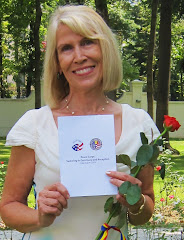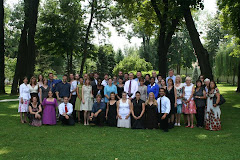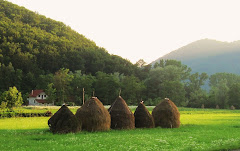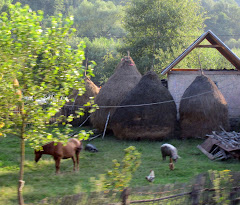 The destination of our Unitarian pilgrimage was Okland, a small village of around 1500 residents, nearly all Hungarian and members of the Unitarian congregation of our partner church. I wasn't sure what to expect since the word "village" is used to describe a number of different smaller settlements throughout Romania. But Okland fits well the American vision of a European village, right down to the cows coming home down the main road at dusk, the geese honking their welcome, and small gardens overflowing with flowers and vegetables. (Photos) It was first mentioned in 1546, but has remains of Roman structures and was apparently a frequent haunt of Attila the Hun whose favorite wife, according to legend, is buried here. The sanctuary of the Unitarian church of the village, our partner, is from the Romanesque era and was altered around the turn of the 16th century in late Gothic style. In 1938 it was doubled in size, but in keeping with the style of the old section. What impresses the visitor is the abundant use of embroidered decorative cloths, red on white, the bright blue paint, and the wonderful ceiling tiles, wood panels painted with nature and folk motifs. These panels were the subject of much debate, apparently, when the 1938 expansion took place. Many did not want to replace the panels, opting for a newer, more elegant look, but thankfully, the minister and other elders were adamant about keeping them and won out. We were glad to be present for a communion service there, led by both our and their ministers, and to exchange gifts, songs, and well wishes with the members. It was a moving service, especially after we had learned their history, the difficulties of trying to meet during the communist era and then later to maintain autonomy and survive in a country 87% Orthodox.****We were hosted by various villagers during our four-day stay, and my friend Anna and I, being the "walkers" in the group, were situated at the home of Rosalia and her husband on the outskirts of town. We liked the walk to the parsonage and church--over the river, past a school and several homes, beside a park, and around the bend to the pretty churchyard garden. The weather couldn't have been more perfect--bright blue skies with sunshine and breezes in the day and a nip in the night air that made sleeping under the farm house quilts feel cozy, especially when Rosalia offered to boil some water for my trusty hot water bottle. Though the villagers all spoke Hungarian, Rosalia and I could communicate on a very basic level in Romanian, a fact most satisfying (and a bit amusing, given my inadequacies) to me. Mostly we relied on a bright young interpreter who was with us during mealtimes. Meals, by the way, ALL meals were preceded by a shot of palinka (strong plum brandy) to aid the appetite and digestion. I could happily accept at lunch and dinner, but at breakfast, I just had to decline. I'm not a "morning person" and struggle with the aid of coffee to wake up. The last thing I need is something that crosses my eyes and makes me want to head back to the pillow.***** Overall, our stay was informative and pleasant, an opportunity to examine our own commitment to our beliefs, a time to come to know and appreciate each other better, a chance to test our willingness to grow--elements, of course, common to all pilgrimages. The tour/pilgrimage ended with our leaving the village for Targu-Mures where the others would begin their return flights to the US. I, however, was given a ride to Cluj where I would take a train, probably my last in Romania, to Oradea to visit dear friends in the area. Part III will be about this bitter-sweet weekend.
The destination of our Unitarian pilgrimage was Okland, a small village of around 1500 residents, nearly all Hungarian and members of the Unitarian congregation of our partner church. I wasn't sure what to expect since the word "village" is used to describe a number of different smaller settlements throughout Romania. But Okland fits well the American vision of a European village, right down to the cows coming home down the main road at dusk, the geese honking their welcome, and small gardens overflowing with flowers and vegetables. (Photos) It was first mentioned in 1546, but has remains of Roman structures and was apparently a frequent haunt of Attila the Hun whose favorite wife, according to legend, is buried here. The sanctuary of the Unitarian church of the village, our partner, is from the Romanesque era and was altered around the turn of the 16th century in late Gothic style. In 1938 it was doubled in size, but in keeping with the style of the old section. What impresses the visitor is the abundant use of embroidered decorative cloths, red on white, the bright blue paint, and the wonderful ceiling tiles, wood panels painted with nature and folk motifs. These panels were the subject of much debate, apparently, when the 1938 expansion took place. Many did not want to replace the panels, opting for a newer, more elegant look, but thankfully, the minister and other elders were adamant about keeping them and won out. We were glad to be present for a communion service there, led by both our and their ministers, and to exchange gifts, songs, and well wishes with the members. It was a moving service, especially after we had learned their history, the difficulties of trying to meet during the communist era and then later to maintain autonomy and survive in a country 87% Orthodox.****We were hosted by various villagers during our four-day stay, and my friend Anna and I, being the "walkers" in the group, were situated at the home of Rosalia and her husband on the outskirts of town. We liked the walk to the parsonage and church--over the river, past a school and several homes, beside a park, and around the bend to the pretty churchyard garden. The weather couldn't have been more perfect--bright blue skies with sunshine and breezes in the day and a nip in the night air that made sleeping under the farm house quilts feel cozy, especially when Rosalia offered to boil some water for my trusty hot water bottle. Though the villagers all spoke Hungarian, Rosalia and I could communicate on a very basic level in Romanian, a fact most satisfying (and a bit amusing, given my inadequacies) to me. Mostly we relied on a bright young interpreter who was with us during mealtimes. Meals, by the way, ALL meals were preceded by a shot of palinka (strong plum brandy) to aid the appetite and digestion. I could happily accept at lunch and dinner, but at breakfast, I just had to decline. I'm not a "morning person" and struggle with the aid of coffee to wake up. The last thing I need is something that crosses my eyes and makes me want to head back to the pillow.***** Overall, our stay was informative and pleasant, an opportunity to examine our own commitment to our beliefs, a time to come to know and appreciate each other better, a chance to test our willingness to grow--elements, of course, common to all pilgrimages. The tour/pilgrimage ended with our leaving the village for Targu-Mures where the others would begin their return flights to the US. I, however, was given a ride to Cluj where I would take a train, probably my last in Romania, to Oradea to visit dear friends in the area. Part III will be about this bitter-sweet weekend.
Tuesday, October 4, 2011
Postlude II: The Village
 The destination of our Unitarian pilgrimage was Okland, a small village of around 1500 residents, nearly all Hungarian and members of the Unitarian congregation of our partner church. I wasn't sure what to expect since the word "village" is used to describe a number of different smaller settlements throughout Romania. But Okland fits well the American vision of a European village, right down to the cows coming home down the main road at dusk, the geese honking their welcome, and small gardens overflowing with flowers and vegetables. (Photos) It was first mentioned in 1546, but has remains of Roman structures and was apparently a frequent haunt of Attila the Hun whose favorite wife, according to legend, is buried here. The sanctuary of the Unitarian church of the village, our partner, is from the Romanesque era and was altered around the turn of the 16th century in late Gothic style. In 1938 it was doubled in size, but in keeping with the style of the old section. What impresses the visitor is the abundant use of embroidered decorative cloths, red on white, the bright blue paint, and the wonderful ceiling tiles, wood panels painted with nature and folk motifs. These panels were the subject of much debate, apparently, when the 1938 expansion took place. Many did not want to replace the panels, opting for a newer, more elegant look, but thankfully, the minister and other elders were adamant about keeping them and won out. We were glad to be present for a communion service there, led by both our and their ministers, and to exchange gifts, songs, and well wishes with the members. It was a moving service, especially after we had learned their history, the difficulties of trying to meet during the communist era and then later to maintain autonomy and survive in a country 87% Orthodox.****We were hosted by various villagers during our four-day stay, and my friend Anna and I, being the "walkers" in the group, were situated at the home of Rosalia and her husband on the outskirts of town. We liked the walk to the parsonage and church--over the river, past a school and several homes, beside a park, and around the bend to the pretty churchyard garden. The weather couldn't have been more perfect--bright blue skies with sunshine and breezes in the day and a nip in the night air that made sleeping under the farm house quilts feel cozy, especially when Rosalia offered to boil some water for my trusty hot water bottle. Though the villagers all spoke Hungarian, Rosalia and I could communicate on a very basic level in Romanian, a fact most satisfying (and a bit amusing, given my inadequacies) to me. Mostly we relied on a bright young interpreter who was with us during mealtimes. Meals, by the way, ALL meals were preceded by a shot of palinka (strong plum brandy) to aid the appetite and digestion. I could happily accept at lunch and dinner, but at breakfast, I just had to decline. I'm not a "morning person" and struggle with the aid of coffee to wake up. The last thing I need is something that crosses my eyes and makes me want to head back to the pillow.***** Overall, our stay was informative and pleasant, an opportunity to examine our own commitment to our beliefs, a time to come to know and appreciate each other better, a chance to test our willingness to grow--elements, of course, common to all pilgrimages. The tour/pilgrimage ended with our leaving the village for Targu-Mures where the others would begin their return flights to the US. I, however, was given a ride to Cluj where I would take a train, probably my last in Romania, to Oradea to visit dear friends in the area. Part III will be about this bitter-sweet weekend.
The destination of our Unitarian pilgrimage was Okland, a small village of around 1500 residents, nearly all Hungarian and members of the Unitarian congregation of our partner church. I wasn't sure what to expect since the word "village" is used to describe a number of different smaller settlements throughout Romania. But Okland fits well the American vision of a European village, right down to the cows coming home down the main road at dusk, the geese honking their welcome, and small gardens overflowing with flowers and vegetables. (Photos) It was first mentioned in 1546, but has remains of Roman structures and was apparently a frequent haunt of Attila the Hun whose favorite wife, according to legend, is buried here. The sanctuary of the Unitarian church of the village, our partner, is from the Romanesque era and was altered around the turn of the 16th century in late Gothic style. In 1938 it was doubled in size, but in keeping with the style of the old section. What impresses the visitor is the abundant use of embroidered decorative cloths, red on white, the bright blue paint, and the wonderful ceiling tiles, wood panels painted with nature and folk motifs. These panels were the subject of much debate, apparently, when the 1938 expansion took place. Many did not want to replace the panels, opting for a newer, more elegant look, but thankfully, the minister and other elders were adamant about keeping them and won out. We were glad to be present for a communion service there, led by both our and their ministers, and to exchange gifts, songs, and well wishes with the members. It was a moving service, especially after we had learned their history, the difficulties of trying to meet during the communist era and then later to maintain autonomy and survive in a country 87% Orthodox.****We were hosted by various villagers during our four-day stay, and my friend Anna and I, being the "walkers" in the group, were situated at the home of Rosalia and her husband on the outskirts of town. We liked the walk to the parsonage and church--over the river, past a school and several homes, beside a park, and around the bend to the pretty churchyard garden. The weather couldn't have been more perfect--bright blue skies with sunshine and breezes in the day and a nip in the night air that made sleeping under the farm house quilts feel cozy, especially when Rosalia offered to boil some water for my trusty hot water bottle. Though the villagers all spoke Hungarian, Rosalia and I could communicate on a very basic level in Romanian, a fact most satisfying (and a bit amusing, given my inadequacies) to me. Mostly we relied on a bright young interpreter who was with us during mealtimes. Meals, by the way, ALL meals were preceded by a shot of palinka (strong plum brandy) to aid the appetite and digestion. I could happily accept at lunch and dinner, but at breakfast, I just had to decline. I'm not a "morning person" and struggle with the aid of coffee to wake up. The last thing I need is something that crosses my eyes and makes me want to head back to the pillow.***** Overall, our stay was informative and pleasant, an opportunity to examine our own commitment to our beliefs, a time to come to know and appreciate each other better, a chance to test our willingness to grow--elements, of course, common to all pilgrimages. The tour/pilgrimage ended with our leaving the village for Targu-Mures where the others would begin their return flights to the US. I, however, was given a ride to Cluj where I would take a train, probably my last in Romania, to Oradea to visit dear friends in the area. Part III will be about this bitter-sweet weekend.
Subscribe to:
Post Comments (Atom)







No comments:
Post a Comment